The Sandy Bridge Preview
by Anand Lal Shimpi on August 27, 2010 2:38 PM ESTSandy Bridge Integrated Graphics Performance
With Clarkdale/Arrandale, Intel improved integrated graphics by a large enough margin that I can honestly say we were impressed with what Intel had done. That being said, the performance of Intel's HD Graphics was honestly not enough. For years integrated graphics have been fast enough to run games like the Sims but not quick enough to play anything more taxing, at least not at reasonable quality settings. The 'dales made Intel competitive in the integrated graphics market, but they didn't change what we thought of integrated graphics.
Sandy Bridge could be different.
Architecturally, Sandy Bridge is a significant revision from what's internally referred to as Intel Gen graphics. While the past two generations of Intel integrated graphics have been a part of the Gen 5 series, Sandy brings the first Gen 6 graphics die to market. With a tremendous increase in IPC and a large L3 cache to partake in, Sandy Bridge's graphics is another significant move forward.
Is it enough to kill all discrete graphics? No. But it's good enough to really threaten the entry level discrete market. Take a look:
Batman: Arkham Asylum

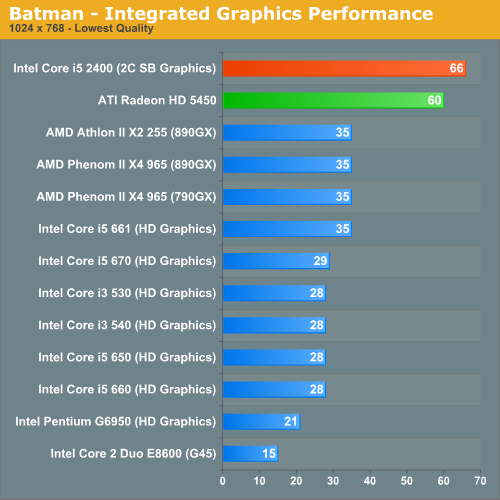
It's unclear whether or not graphics turbo was working on the part I was testing. If it was, this is the best it'll be for the 6 EU parts. If it wasn't, things will be even faster. Comparisons to current integrated graphics solutions are almost worthless. Sandy Bridge's graphics perform like a low end discrete part, not an integrated GPU. In this case, we're about 10% faster than a Radeon HD 5450.
Assuming Sandy Bridge retains the same HTPC features that Clarkdale has, I'm not sure there's a reason for these low end discrete GPUs anymore. At least not unless they get significantly faster.
Note that despite the early nature of the drivers, I didn't notice any rendering artifacts or image quality issues while testing Sandy Bridge's integrated graphics.
Dragon Age Origins
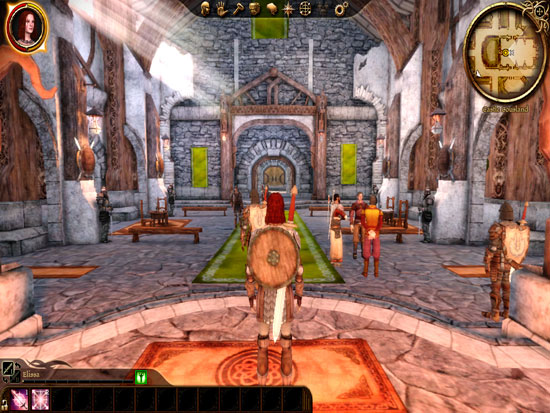
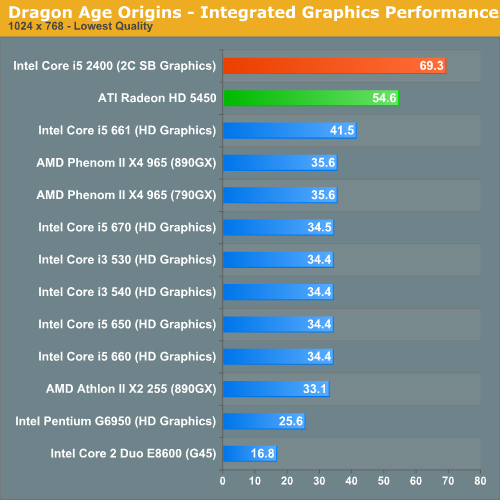
The Sandy Bridge advantage actually grows under Dragon Age. At these frame rates you can either enjoy smoother gameplay or actually up the resolution/quality settings to bring it back down to ~30 fps.
Dawn of War II
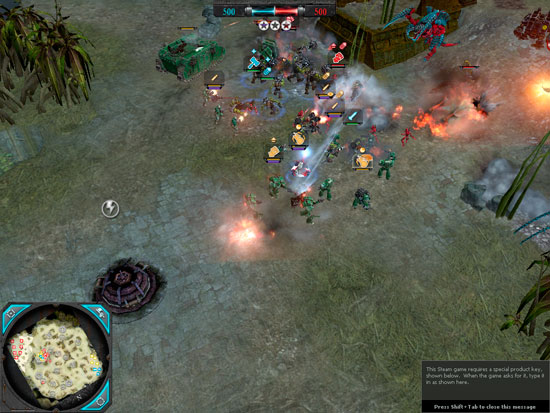
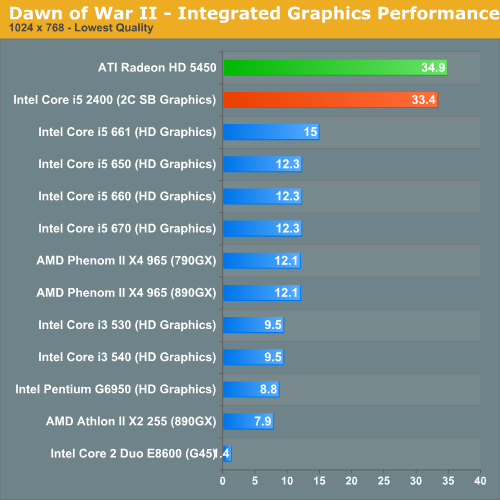
It's not always a clear victory for Sandy Bridge. In our Dawn of War II test the 5450 pulls ahead, although by only a small margin.
Call of Duty Modern Warfare 2
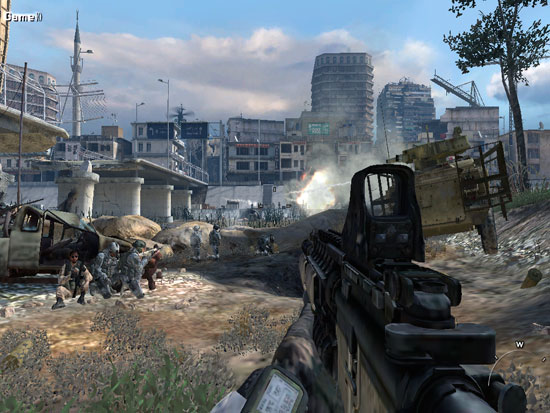
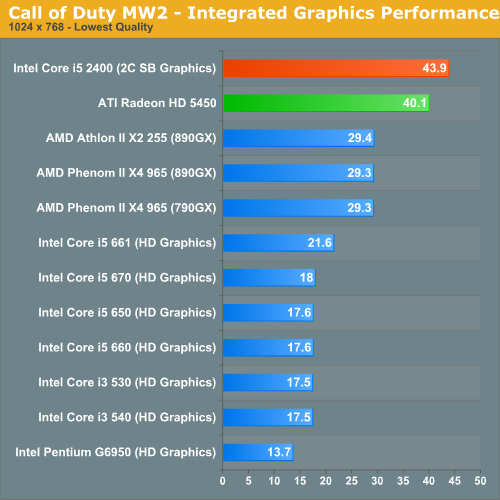
Sandy is one again on top of the 5450 in Modern Warfare 2. Although I'm not sure these frame rates are high enough to really up quality settings any more, they are at least smooth - which is more than I can say for the first gen HD Graphics.
BioShock 2
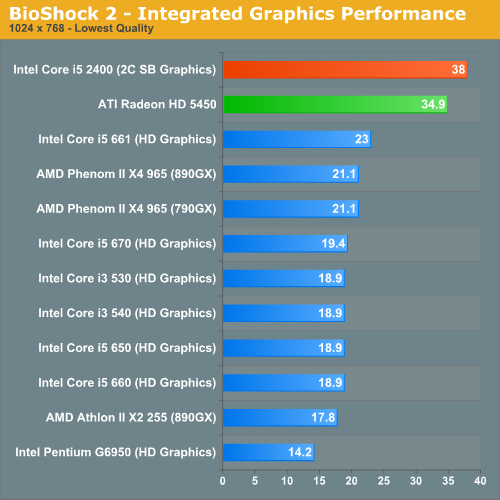
Intel promised to deliver a 2x improvement in integrated graphics performance with Sandy Bridge. We're getting a bit more than that here in BioShock 2.
World of Warcraft
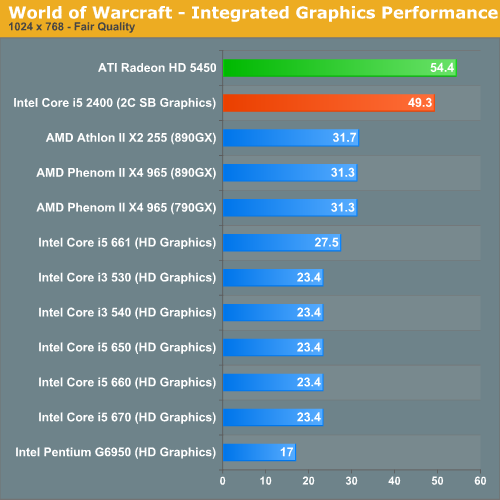
World of Warcraft is finally playable with Intel's Sandy Bridge graphics. The Radeon HD 5450 is 10% faster here.
HAWX
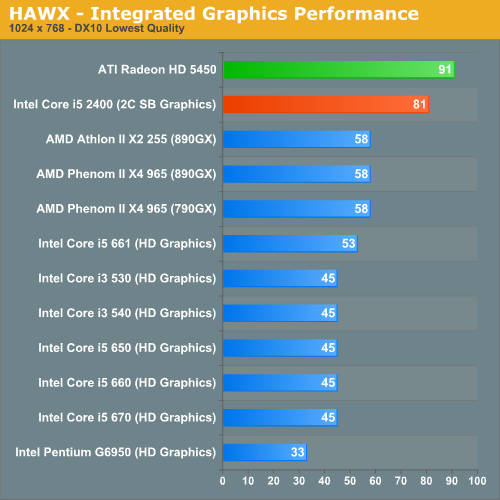
Sandy Bridge Graphics Performance Summary
This is still a very early look. Drivers and hardware both aren't final, but the initial results are very promising. Sandy Bridge puts all current integrated graphics solutions to shame, and even looks to nip at the heels of low end discrete GPUs. For HTPC users, Clarkdale did a good enough job - but for light gaming there wasn't enough horsepower under the hood. With Sandy Bridge you can actually play modern titles, albeit at low quality settings.
If this is the low end of what to expect, I'm not sure we'll need more than integrated graphics for non-gaming specific notebooks. Update: It looks like all notebook Sandy Bridge parts, at least initially, will use the 12 EU IGPs. Our SB sample may also have been a 12 EU part, we're still awaiting confirmation.










200 Comments
View All Comments
tatertot - Tuesday, August 31, 2010 - link
Can you also confirm whether or not the GPU turbo was also disabled?DanNeely - Saturday, August 28, 2010 - link
Do you think Intel will be sharing preliminary performance/pricing data on LGA 2011 by the time that the first LGA 1155 parts start shipping? I'm on 1366 now and would like to know if staying on the high end platform will be a reasonable option or if there isn't any point in holding off for another 6 months on my upgrade.Anand Lal Shimpi - Saturday, August 28, 2010 - link
I wouldn't expect any near-final LGA-2011 performance data until Q2 next year, well after the LGA-1155 launch.Take care,
Anand
Casper42 - Saturday, August 28, 2010 - link
2 things jumped out at me1) No USB3 - Major FAIL. Putting USB3 in an Intel chipset will drive huge adoption rates rather than this limping in BS by manufacturers today. Not to mention that for Hard Drives, USB2 has been a bottleneck for a long time whereas only top end SSDs today are maxing out SATA3
2) 2 chips with Quad Core and no HT that are identical except for Clock speed and one of them is essentially the 400 and the other is the 500? WTF? Call them the 2410, 2420, 2430, etc. That gives you like 8 or 9 speed bins for that family. Whomever is doing the numbering at Intel needs a swift kick to the head to get them back on track mentally as things just get more and more confusing. You have the i3/i5/i7 today, why not just change it to:
i2 = Dual Core no HT/Turbo
i3 = Dual Core with HT and/or Turbo
i4 = Quad Core no HT/Turbo
i5 = Quad WITH
i6 = Six without
etc
As it stands now we have i5 with both dual and quad core and i7 with 4 and 6. just doesnt make sense.
dertechie - Saturday, August 28, 2010 - link
That's quite the IPC improvement there. Not quite Netburst to Core 2 but a lot more than I expected (I was expecting something on the order of 5%, with most gains coming from ramping clocks with the extra headroom of 32nm).Question is, do I want the i5-2500K more than I loathe Intel's motherboard department? I'm seeing them bring out new sockets almost as often as new processor families, which really, really does not make me confident in the socket's future.
I will wait at least for Bulldozer benches before buying whatever makes sense at that time (okay, probably weighted in AMD's favor). I've lasted 4 years on this Pentium D, I can live another half of one.
IntelUser2000 - Saturday, August 28, 2010 - link
Why do some people still compare Netburst vs. Core 2? The Pentium 4 generation was a clock speed focused that that FAILED to realize its clock speed potential so it looked really bad compared to Core 2.Compared to Core Duo Core 2 was only 15-20% faster. Sandy Bridge manages to do another 20%, which is really good in a generation, yea?
ssj4Gogeta - Saturday, August 28, 2010 - link
Pentium D to SB will be such a huuuuge jump, lol.neslog - Saturday, August 28, 2010 - link
Your excellent article was exciting to read. Thank you!I noticed a small typo on the Windows 7 Gaming Performance page in the first line under the Data Recovery chart : "Clock for clock...to the i7{5} 760..."
ET - Saturday, August 28, 2010 - link
I think that the integrated graphics here are a game changer. Sure nobody will look to them for serious gaming, but finally they're at a point where if you buy any CPU you will be able to play most games, even if at low settings. I'll be looking forward especially to the mobile CPU's. With Bobcat around the corner, I guess next year we will finally see mainstreams notebooks become capable of some game playing, which will be great (and bad for NVIDIA).Exodite - Saturday, August 28, 2010 - link
What I'd like to see is something like Nvidia's Optimus make it to the desktop. With both AMD and Intel going for on-chip integrated graphics the market is practically begging for a unified standard for graphics switching.The next-generation IGPs look to be competent enough for anything but high-end gaming, which means I should be able to power down my discrete graphics card completely most of the time. The end result would be significant reductions in noise generation, power usage and heat emissions.
Having discreet graphics cards reduced to basically connector-less, slot-in cards for on-demand co-processing seems the logical step.